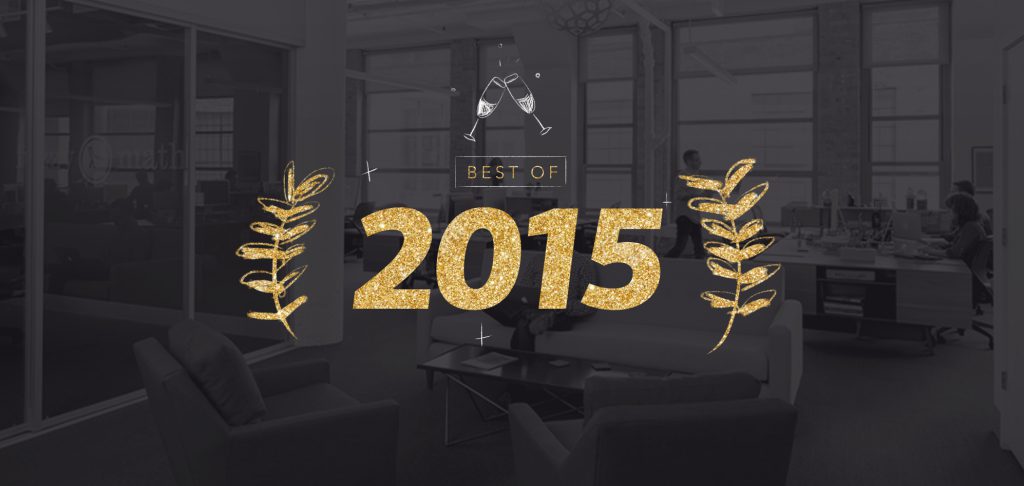
How is it December already? The year has flown by at Fuzzy Math, with many great projects from clients both new and old. As we begin to settle in for the Chicago winter, we’ve been reflecting on 2015. Below, you’ll find some of our favorites from our blog, as well as things from around the web that impressed, inspired, and amazed us over the past year.
Happy holidays! We’ll see you in 2016.
Favorites from Our Blog
UX Design Principles for Wearables
Throughout the spring and summer, our team used and evaluated numerous wearable devices, culminating in the publication of Fuzzy Math’s UX Design Principles for Wearables (PDF, 2.9mb). Curious to know more about the wearables we tested, or about the wearables project? Check out Wearables from 2015!
Detaching Information Architecture from the UI
We’re always exploring different approaches to the work we do, and this year’s been no different. This exploration of how and when to dig into the information architecture of a complex system versus the user interface was the result of many conversations throughout our office, and led to a continuing effort to design our own processes.
Enterprise UX: Designing Organizational Culture Wrap-up
This year saw Fuzzy Math as a sponsor for the fantastic Enterprise UX 2015 Conference in San Antonio. Leading up to the conference, we dug into each of the conference’s four themes to discuss things we’ve learned about UX design with our enterprise clients. After the conference, we recapped the talks on those themes. Fuzzy Math Co-founder Ben Ihnchak said, “As an attendee, this was my favorite day of the conference. Phil Gilbert’s talk about the massive design-driven culture change happening at IBM and watching Dave Grey ‘draw his keynote’ were highlights of the year for me.”
Building Interactive Mobile Prototypes Within the UX Workflow
With a wealth of design tools being released and updated (and, for better or worse, acquired) in the past year, we spent a lot of time investigating ways to better create and showcase design work. In this article, we outlined some of the tools available at the beginning of the year, and ways we’ve found those helpful throughout the UX design process.
Happy 6th Birthday, Fuzzy Math
As we have since 2009, we celebrated another year as a User Experience Design firm in Chicago — a role we look forward to maintaining for a long while. Want to get to know us even better? The year 2015 also saw the publication of Fuzzy Math Focus blog posts on Fuzzy Math Co-founder Fuzzy Math Focus: Mark Baldino and UX Designers Fuzzy Math Focus: Carl Duffield and Nicole Sciackitano.
Our Favorite Design Links of 2015
The Language of Modular Design
A shared language within a design system can benefit more than just the design team. It helps unify an entire service offering in a collaborative, gradual process. We liked the tips here for finding agreement on a shared language. It’s concrete and practical while also all about “ontology,” which is pretty meta.
How Apple is Giving Design a Bad Name
Don Norman and Bruce Tognazzini, visionaries in the design and UX world, get in the Festivus spirit by airing their grievances with recent Apple design decisions. A must-read for any designer.
Design Machines
An intense and candid look at “an internet designed by machines, and the mushy, emotional weapons we can use to fight back.”
Apollo 17 in Real-Time
Combining audio, video, and photographs from the actual event, this site allows you to relive Apollo 17 in real-time. An interesting timeline interaction, one of Fuzzy Math’s favorite interaction patterns, let’s you browse 300+ hours of activity with ease.
There’s a Chat For That
After a few trial runs in 2014, this was the year Fuzzy Math got fully onboard the Slack hype train, recognizing the power of messaging and automation in our own office and starting to think of the many possibilities that messaging-oriented interfaces provide. Matt’s thoughts on turning iMessage into a platform sparked thoughts throughout the year about how messaging could factor into the ecosystems of both our consumer and enterprise clients.
The Cost of Frustration
Few things are as nice as hearing “oh, this is so much easier!” in a user test. Here, Jared Spool reveals just how costly frustrating systems can be, and why it’s so important for thoughtful design to help alleviate those frustrations.
Information Foraging: Why Google Makes People Leave Your Site Faster
Through research in human-computer interaction, we can better understand how people seek out information and how to optimize for a global user base that tends to visit sites only briefly. Is your site snackable?
The Psychology of Numbers in Design
This look at how we subconsciously interpret and react to numbers, whether in prices or other data, shows how very subtle differences in display can impact behavior.
The Future of Web Design is Hidden in the History of Architecture
We like architecture — between work with our friends at the Chicago Architecture Foundation, and a tour of the incredible architecture of Chicago by way of its historical bars, it was on our minds a lot this year. This exploration of how web design trends have mirrored historical trends in architecture made us evaluate our own work, and think about where we can see design going in the future.